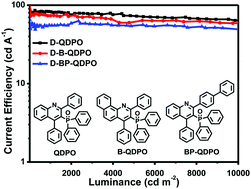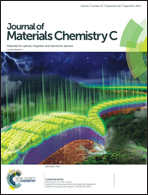Novel phosphine oxide-based electron-transporting materials for efficient phosphorescent organic light-emitting diodes†
Abstract
Three phosphoryl quinoline derivatives, (2,4-diphenylquinolin-3-yl)diphenylphosphine oxide (QDPO), (2,4-diphenylbenzo[h]quinolin-3-yl)diphenylphosphine oxide (B-QDPO) and (2-([1,1′-biphenyl]-4-yl)-4-phenylquinolin-3-yl)diphenylphosphine oxide (BP-QDPO), comprising two electron-transporting moieties namely a nitrogen heterocycle and a phosphoryl (P![[double bond, length as m-dash]](https://www.rsc.org/images/entities/char_e001.gif) O) group, have been designed and synthesized. All materials exhibit suitable LUMO (lowest unoccupied molecular orbital)/HOMO (highest occupied molecular orbital) levels, large triplet energy gaps (ET > 3.1 eV) and excellent thermal stabilities. These materials were utilized as electron transporting materials for fabricating green phosphorescent organic light-emitting diodes with the configuration of indium tin oxide (ITO)/MoO3 (5 nm)/TAPC (di-[4-(N,N-ditolyl-amino)-phenyl]cyclohexane) (30 nm)/Ir(tfmppy)2tpip (bis(4-trifluoromethylphenylpyridine-N,C2′)iridium(tetraphenylimido-diphosphinate)) (8 wt%): mCP [1,3-bis(N-carbazolyl)benzene] (10 nm)/QDPO or B-QDPO or BP-QDPO (30 nm)/LiF (1 nm)/Al (100 nm). These devices exhibited decent performances with a peak current efficiency above 80 cd A−1 and an external quantum efficiency above 20% as well as negligible efficiency roll-off.
O) group, have been designed and synthesized. All materials exhibit suitable LUMO (lowest unoccupied molecular orbital)/HOMO (highest occupied molecular orbital) levels, large triplet energy gaps (ET > 3.1 eV) and excellent thermal stabilities. These materials were utilized as electron transporting materials for fabricating green phosphorescent organic light-emitting diodes with the configuration of indium tin oxide (ITO)/MoO3 (5 nm)/TAPC (di-[4-(N,N-ditolyl-amino)-phenyl]cyclohexane) (30 nm)/Ir(tfmppy)2tpip (bis(4-trifluoromethylphenylpyridine-N,C2′)iridium(tetraphenylimido-diphosphinate)) (8 wt%): mCP [1,3-bis(N-carbazolyl)benzene] (10 nm)/QDPO or B-QDPO or BP-QDPO (30 nm)/LiF (1 nm)/Al (100 nm). These devices exhibited decent performances with a peak current efficiency above 80 cd A−1 and an external quantum efficiency above 20% as well as negligible efficiency roll-off.



 Please wait while we load your content...
Please wait while we load your content...